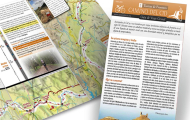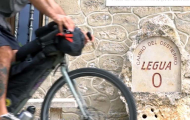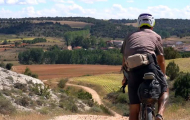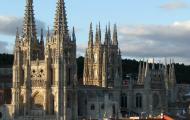The Exile route by Gravel Bike
BURGOS - SORIA - GUADALAJARA
Riding the Exile Route on a Gravel Bike. In the footsteps of el Cid, on his way to exile, through the old kingdom of Castile.
We invite you to accompany el Cid on his exile, from Vivar del Cid - his home town - to the magical fortress of Atienza, in Guadalajara. Cross the medieval border of the Duero River and follow in his footsteps through the valleys and mountains of the provinces of Burgos, Soria and Guadalajara.
- Route: From Vivar del Cid (Burgos) to Atienza (Guadalajara)
- Provinces: Burgos, Soria, Guadalajara
- Kilometres: 298 km approx.
- Recommended days: 5 days (4 nights) including the prologue stage Vivar del Cid - Burgos (13 km), which will allow you to get to know the capital of Burgos in depth.

| TECHNICAL DATA | ||
| Distance: 299 km | Cumulative ascent: 4,570 m | Physical difficulty: Medium |
| Estimated time: 4/5 days | Accumulated descent: 4,270 m | Technical difficulty: Low |
| This is a route designed for gravel bikes and is 100% cyclable, following rural roads with a good surface, comfortable tracks and lonely roads. The route does not offer significant slopes or significant complications, so you will be able to move at a good pace and enjoy a wide variety of landscapes. | ||
What information about this route you can download on this page
PDF gravel guide (contains detailed maps)
The tourist brochure (which you can request at any of the tourist offices along the route).
Remember that you can get more information about each route for free at the Camino del Cid Tourist Offices: including brochures and the safe-conduct.
Download our free travel app
We recommend you download our mobile travel app, available on iOS and Android. The app contains all our routes, you'll never get lost and you'll find information on 4,500 geo-referenced points (Cidian enclaves, places to see, accommodation, pass stamping points, etc.).
The app is free, updated daily and does not require registration. It also works in environments without coverage, so during installation and when you first turn it on, depending on your connection, it may take a few minutes to get it up and running, so be patient, it's worth it!
The plot: In the footsteps of el Cid
Este tramo sigue en líneas generales los primeros días del destierro del Cid narrados en el Cantar, aunque también incluye otros pasajes del poema, como la Afrenta de Corpes. El Cid, desterrado, sale de Vivar con un puñado de caballeros y la orden real de abandonar Castilla en nueve días, plazo que el Cid utilizará para dejar a sus hijas y a su mujer en el monasterio de San Pedro de Cardeña, pertrecharse, y reforzar su reducido grupo de fieles alistando a nuevos caballeros y soldados. Aunque el Cid abandona Castilla justo en la sierra de Pela, en el actual límite entre Soria y Guadalajara (sierra que en 1081 marcaba la frontera natural entre los reinos de Castilla y Toledo), nuestro itinerario finaliza en el siguiente núcleo de importancia, ya en territorio musulmán: la villa histórica de Atienza, una plaza militar andalusí de frontera de gran importancia en los siglos X y XI. Intercala esta marcha al exilio el famoso episodio de La Afrenta de Corpes, narrado en el Cantar, en el que las hijas del Cid son ultrajadas y abandonadas por sus maridos. Tradicionalmente los estudiosos han ubicado este suceso legendario en el término de Castillejo de Robledo.
The journey: what you will find
The landscape alternates between dry crops in the valleys of the Arlanza and Duero rivers and savin groves, oak groves, pine forests, scrubland and moorland. The route crosses six Natural Spaces, including the juniper groves of the Arlanza and La Yecla valleys and the Soria area of the Duero river, of great environmental and geopolitical importance during the Middle Ages . This importance is reflected in the numerous watchtowers and castles that mark this unique area, between Langa de Duero and Berlanga de Duero, whose emblem is the colossal Caliphate fortress of Gormaz, of which el Cid was the commander.
You will pass by two of the great founding monasteries of Castile: San Pedro de Cardeña and Silos, as well as the monastery of La Vid, next to the waters of the Duero, and very close to the monastery of Arlanza (8 km from Covarrubias). You will visit mythical places in the history of el Cid, such as Vivar del Cid, San Pedro de Cardeña, Castillejo de Robledo or San Esteban de Gormaz among others and, of course, Burgos, with a good infrastructure for cycle tourists. En route you will find Romanesque traces in the cloister of Santo Domingo de Silos, in the paintings of the hermitage of San Miguel in Gormaz, in the churches of San Esteban de Gormaz and in many other towns that conserve examples of the so-called rural Romanesque, of great evocative and evocative power.
This section is dominated by small, peaceful villages with a medieval "aroma", such as Covarrubias, Santo Domingo de Silos, Peñaranda de Duero, Langa de Duero, San Esteban de Gormaz, El Burgo de Osma, Berlanga de Duero and of course, at the end of this road, already in Guadalajara, the impregnable Atienza, all of them declared Historic and/or artistic sites.
El Cid and culinary delights
As far as gastronomy is concerned, on this route don't forget to try the famous Burgos black pudding, a benchmark of traditional Burgos gastronomy based on hearty stews, such as olla podrida, and where roast suckling lamb also stands out, dishes that can also be found in Soria and Guadalajara. Passing through Soria, a mycological paradise, will provide the traveller, especially in season, with succulent surprises prepared with chanterelles, boletus, oyster mushrooms, amanitas, mushrooms and truffles, which are increasingly present on the Soria table, as well as game stews (roe deer, deer and wild boar). Among the fish, trout and cod prepared in a variety of ways are typical of the three provinces. Although there are other designations of origin, such as Arlanza, the most representative wines on this route are those of Ribera del Duero, which are internationally renowned. Finally, we recommend you round off this culinary itinerary with one of its typical desserts, whether it be Burgos cheese, accompanied by walnuts and honey, or any of the many sweets and pastries made with butter from Soria.
Scenic or Singular roads
The name "Singular Roads" of the Camino del Cid is used to designate those stretches of road with a special cycling, scenic, historical or artistic significance. On this route you can find the following Singular Roads:
BU 911 between Santo Domingo de Silos and the turn-off to Peñacoba. Burgos
The road starts in the village of Silos, whose monastery has a world-renowned Romanesque cloister, and crosses the natural area of the Sabinares del Arlanza with a stop at La Yecla, a narrow limestone gorge sheltered by high walls where a large number of birds of prey nest.
SO 4228 and SO 4126 between Navapalos and Gormaz (15 km). Soria
It is very exciting to cross the Duero next to Navapalos and come across this small village, so closely linked to the Cantar, watched over by a solitary Islamic watchtower. We leave it to face a short but fun little port with little traffic and wonderful views of the Duero river valley (a protected natural area), where we arrive after a descent to catch a glimpse of the great Caliphal fortress of Gormaz and the Romanesque chapel of San Miguel among the tops of poplars, ashes and willows.
Layout and signposting
We have designed a route that is 100% adapted for gravel bikes, following rural roads with a good surface, comfortable tracks, asphalted roads and lonely roads. There is no signposting of the gravel route as such, but as it coincides to a large extent with the MTB and hiking routes, you will have to pay attention to the signposting on these sections.
We recommend that you download the track or the App, and before starting your journey, check theRoute Alerts box in our map viewer, which shows you the most important incidents that you may encounter along the way: high vegetation, interrupted crossings, road works, fallen or missing signs and any other obstacle that you need to be warned about.
Roads
Part of the route is on secondary roads with little or no traffic. In any case, do not forget to drive with caution and make yourself visible to vehicles.
Climatology
Our route runs through the foothills of the Iberian System with altitudes ranging from 825 m in Langa de Duero to 1,375 m in Miedes de Atienza. These conditions give the climate a markedly continental character where the Mediterranean influence leaves its mark in a drier summer. In general terms, winters last from mid-November to the end of March. Frosts are not uncommon even outside winter, and dawns are generally cold, so you should always take a warm jacket and windbreaker, even in summer. In winter, snowfall is not uncommon, although there are no areas where it is continuous, affecting the traveller only occasionally. Rainfall peaks in spring and autumn, although it is not usually torrential and does not represent a major obstacle for a well-prepared cyclist.
Practical advices
Length of the stages: ideally, each person should define their stages according to their personal strengths and interests: some people prefer the sporting aspect, the cultural dimension of the trip or the simple sensory pleasure of enjoying landscapes and situations at a leisurely pace. The stages we propose are a mixture of all of these, and are designed so that the average cyclist in stable weather conditions can enjoy the itinerary at their leisure.
Groceries and spare parts. One of the great attractions of the Camino del Cid is that it runs mostly through very attractive but sparsely populated places: many villages are very small and have no grocery shops. It is very important that, unless you have planned to eat in a bar or restaurant, you carry some food in your saddlebags (sandwiches, nuts, energy bars...) that can help you out of a tight spot. Don't forget to take water with you. There are fountains in most of the villages: don't forget to fill up your tank before leaving them. And the same goes for bike parts: don't forget to take a repair kit with you on the road: the more complete it is, the more relaxed you'll be when you travel. Welcome to the Middle Ages.
Book your accommodation in advance. You will be travelling through one of the most sparsely populated areas in Europe. Some towns are very small and their infrastructure is limited. Book your accommodation at the end of the stage in advance, and if you change the end of the stage, check that there is accommodation at that point.
Don't forget to wear a helmet: it is legally compulsory for adults on all road sections outside the city and for children under 16 years of age it is compulsory at all times.
Get your Salvoconducto. The Salvoconducto is a personalised "passport" that you can stamp in many places along the Camino del Cid.
Your literary guide. It seems an unnecessary burden, but for many it is an essential guide: don't forget to bring a Cantar de mío Cid; you will be able to recreate some of its passages in situ. If your old Spanish is weak, a modernised edition is preferable!
How to get there... and back
To find out how to get to Vivar del Cid, click on the information about the municipality. The normal route is to get to Burgos, which has a train station, bus station and airport. To find out about the different means of transport in Burgos, click on the information about the municipality.
From Atienza you can return to your place of origin by bus. For more information, click on the info of the municipality.
Rev. ALC: 19.05.25












